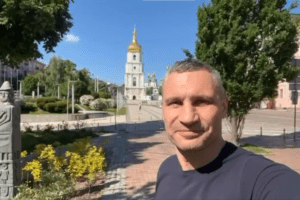
New US Ambassador to Ukraine Bridget Brink has received a Ukrainian visa. Now she will be able to arrive at the embassy in Kyiv, said Ukrainian Ambassador to the United States Oksana Markarova.
“It is a great pleasure to issue a visa and meet with a colleague – the new US Ambassador to Ukraine Bridget Brinks. Ukraine has always had the best leaders of the American diplomatic mission, who were not only highly professional diplomats, but also wonderful people and examples of public service. And this time, I did not exception!” Markarova wrote on Facebook on Saturday, noting that she “expects active joint work at a defining time in our struggle for independence and democracy!”

A film about Mariupol, shot by Lithuanian documentary filmmaker Mantas Kvedaravičius, won the Golden Eye Special Jury Prize at the Cannes Film Festival, the press service of the Verkhovna Rada reports.
“The documentary “Mariupoli 2″ was edited from material that the Lithuanian director Mantas Kvedaravičius filmed before his death. He arrived in Mariupol in March and filmed the lives of civilians. Then he died,” the message on the telegram channel says.
The jury of the Cannes Film Festival noted the film as “very radical, courageous, artistic and existential” and emphasized that it cannot be compared with any other film in the competition.
As reported, the Lithuanian documentary filmmaker Kvedaravichyus died in Mariupol (Donetsk region) on April 2. He is the author of the film “Mariupoli” released in 2016 about life in front-line Mariupol, which was presented at the Berlin International Film Festival.
CANNES FILM FESTIVAL, DOCUMENTARY FILM, MARIUPOL, SPECIAL PRIZE

601 enterprises have completed relocation from areas where hostilities continue under the state relocation program, 390 of them have already resumed work at new sites in the western regions of Ukraine, the Ministry of Economy reported.
“Another 87 enterprises are at different stages of transportation. Soon another 151 enterprises will move, which are currently on the routes or draw up the necessary documents,” the information on the ministry’s website says.
According to it, the most popular areas for relocation of enterprises are Zakarpattia, Lviv and Chernivtsi. The business also finds new places to locate its facilities in Ternopil, Ivano-Frankivsk, Vinnitsa and other regions.
The movement of equipment is carried out by the facilities of Ukrzaliznytsya, Ukrposhta or by its own resources (with compensation), reminds the Ministry of Economy.
As reported, the program to move Ukrainian production from the zone of active hostilities started in mid-March. According to the head of the parliamentary committee on finance, tax and customs policy of Ukraine, Danila Getmantsev, as of March 27, 1,120 applications were received under the evacuation program, of which 368 were transferred for transportation. By this date, the number of displaced enterprises under the evacuation program has reached 89, of which 47 have already resumed work in a new location.
The Ministry of Economy then updated the data as of April 5: the number of applications for relocation increased to 1424, relocated enterprises – up to 178, resumed work – up to 67.
According to the Ministry of Economy, as of May 12, the number of displaced enterprises increased by 510, a

German Ambassador to Ukraine Anka Feldhusen discussed with Ukrainian Finance Minister Serhiy Marchenko the provision of further financial assistance to Ukraine.
“I discussed with Finance Minister Serhiy Merchenko the current state of the financial sector and the provision of grant (1 billion euros) assistance to Ukraine from Germany. I am glad for close cooperation between the ministries of finance of our countries,” Feldhusen wrote on Twitter on Sunday.

Sleep is physiologically necessary for a person and is an important condition for his health. National health organizations around the world recommend at least 6-7 hours of sleep a night and warn that lack of sleep can lead to a number of diseases, as well as its excess.
The largest study to date has shown that the global increase in temperature caused by the climate crisis is leading to a reduction in the duration of sleep in people around the world.
For health and well-being, a person needs a night’s sleep of at least 7 hours. However, global warming increases the air temperature at night even faster than during the day. The study showed that on average a person loses 44 hours of sleep per year, which is equal to 11 nights.
As the temperature of the earth rises, the duration of sleep decreases. This change has a particularly strong impact on certain groups of the population. When the temperature rises by one degree, lack of sleep is observed in women, people over 65 years of age and residents of poor countries. Scientists studied the data of 47,000 people who wore tracker bracelets.
Previous studies have shown that an increase in air temperature is harmful to human health. The risks of a heart attack, a tendency to depression, which can eventually lead to suicide, increase in injuries, accidents, and reduced performance. Lack of sleep is also associated with such disorders. Scientists have suggested that the disturbed mode can serve as a starting point, which leads to such unfortunate consequences. Unfortunately, the human body cannot adapt to hotter nights.
“For most of us, sleep is a familiar part of our daily lives. We spend nearly a third of our lives sleeping,” said study leader Kelton Minor from the University of Copenhagen. “More and more people around the world are sleep deprived,” he added.
“In this study, we provide indisputable evidence that an increase in average temperature disrupts human sleep patterns. And this is just the tip of the iceberg, as the estimates are based on careful, conservative calculations,” Professor Minor said.
Reduced sleep duration due to warmer nights affects a huge number of people. If you take a city with a population of one million people, then at temperatures above 25 degrees Celsius, about 46,000 people will suffer from inadequate sleep. “If we look at India and Pakistan, which are in a heatwave and heatwave zone, we already see billions of people suffering from insufficient sleep,” Minor said.
In a study published in the journal One Earth, scientists analyzed outdoor sleep data. Higher temperatures have been found to shorten sleep duration by taking longer to fall asleep. The human body needs to cool down before deep sleep, but this is more difficult when the ambient temperature is elevated.
The researchers found that the effect of warm nights on the human body is noticeable in all countries, regardless of climate. A negative effect is already observed at temperatures above 10 degrees.
“Unfortunately, we have not found evidence that people who live in warm countries are less susceptible to the effects of higher temperatures on sleep. We expected that their body would adapt better, but this is not so, ”said Professor Minor.
Professor Minor believes that the path that the world has chosen, upsetting the balance in the environment, will have consequences for every person.
“Our joint decisions as representatives of society can cost us dearly,” he added.

Kyiv Mayor Vitaliy Klitschko congratulated the people of Kyiv on the City Day, the press service of the Kyiv City State Administration reported.
“Kyiv… Ancient and modern. Cozy and energetic. Our city has been standing on the hills of the Dnieper for 1540 years already! Proud, rebellious, beautiful. And together we make it even better! For the soul of the city is its people! Happy Kyiv Day, dear people of Kiev! Happy birthday, our beloved city! Glory to Ukraine! Glory to Kyiv!”, the press service quotes Klitschko’s words.
It is noted that on Sunday Kyiv is 1540 years old from the date of its foundation.